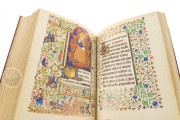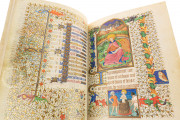The Hours of Marguerite d'Orléans is a Christian prayer book most likely commissioned by Richard d'Etampes, Duke of Brittany, in Rennes for his bride on the occasion of their wedding in 1426 or shortly after. It includes forty-two miniatures by the Master of Marguerite d'Orléans, including scenes from the lives of the Virgin Mary and Christ. The letters R and M appear frequently in painted initials. Around 1450, Marguerite commissioned additional border decorations from Étienne Sauderat, a Parisian artist from the circle of the Bedford Master.
The manuscript displays an enchanting variety of scenes from everyday life. The embellishments of this devotional books include full-page miniatures for the major sections representing scenes from the New Testament and the images of the saints, along with calendar medallions framed in gold, and historicized borders depicting vivid scenes of medieval life.
The Book of Hours of Marguerite d'Orléans and the French Royal Family
Marguerite d’Orléans (1404-1466) was the granddaughter of the French king, Charles V, and the great-niece of Jean, Duke of Berry. Both Charles V and Jean de Berry were highly educated, and both are known for their rich commissions of manuscripts. Marguerite might have shared the passion for books with her forefathers.
This Book of Hours named after Marguerite d’Orléans was made for her personal use. It has been suggested that the occasion for the production of this manuscript was the celebration of her wedding with Richard d’Etampes, Duke of Brittany, in 1426. The miniatures bear their joint coats-of-arms, and a portrait of Marguerite praying Mary presents the feature of the owner of the manuscript in a devotional context.
The Imaginative Illuminations of the Book of Hours of Marguerite d'Orléans
The miniatures and the ornament in the borders, enriched with gold and silver, were made around the year 1430 by the Master of Marguerite d’Orléans. Around 1450 Marguerite d’Orléans decided the decoration of the manuscript and appointed Étienne Sauderat, an artist from the circle of the Bedford Master, to provide the book with additional decoration in the margins. The Master of Marguerite d’Orléans was probably trained in Paris and he knew well the production of the Boucicaut Master.
The influence of the Limbourg brothers also appears in this devotional book. The images in the margins present diverse facets of medieval life, including knights engaged in tournaments and pilgrims traveling to Santiago de Compostela.
The binding shows a remarkable leather mosaic made in the years 1725-1733. The work has been attributed to Antoine-Michel Padeloup, the royal bookbinder to Louis XV.
We have 1 facsimile edition of the manuscript "Hours of Marguerite d'Orléans": Stundenbuch der Margarete von Orléans facsimile edition, published by Quaternio Verlag Luzern, 2013
Request Info / Price
























